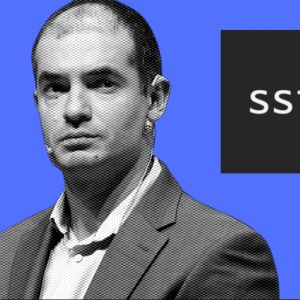Summary Semler Scientific has shifted focus to Bitcoin accumulation, but its stock underperforms BTC and MSTR despite aggressive treasury moves. The stock trades at a premium to its BTC holdings, reflecting both the core healthcare business and Bitcoin strategy, but isn't a bargain. Recent negative free cash flow, declining healthcare revenues, and legal uncertainties add risk and cloud the investment case. Given the fair valuation, execution risks, and better alternatives for Bitcoin exposure (buying BTC directly), I rate SMLR stock as a Hold. Semler Scientific ( SMLR ) used to just be a healthcare technology company focused on a cardiovascular testing product, but it's now like a mini Strategy Inc. ( MSTR ) with its Bitcoin ( BTC-USD ) treasury ambitions. While it still has a small underlying healthcare business, Semler is now clearly a Bitcoin-focused company, buying up the asset as fast as it can and using debt and share issuances to do so. It's one of the largest corporate holders of BTC globally. The interesting thing is, if you look at the performance of Bitcoin and MSTR this year, up about 18% and 31%, respectively, and then look at Semler's performance of -38%, you'll notice a huge disconnect. Some may view this as an opportunity. I mean, SMLR stock is down more than 55% from its November 2024 swing high, while MSTR is off "just" 29% from its November high. At the same time, BTC is trading near an all-time high. So, what's going on with Semler stock? Should you buy it? There are a few reasons to buy but also a few reasons to avoid, and I don't think there's a clear opportunity here relative to buying BTC itself. I believe the stock is more or less fairly valued despite the underperformance. That's because Semler's market cap is still above the value of its BTC holdings (especially when factoring in net debt). So, I believe the difference between the market cap and the net value of BTC holdings can be thought of as how much the market is valuing the underlying health business, and I think the valuation the market assigns is probably fair but not a bargain. More detail on that later. The premium to the BTC holdings likely also prices in future optionality and leverage, so it's a combination of that and the core business. Another positive note to factor is that the stock has pulled back from a big run-up, so from a technical perspective, it could be ready for a short-term bounce. However, there are some risks involved. First of all, the business generated negative free cash flow in Q1 (which is highly unusual for this company), creating uncertainty. Second, it's hard to know the future trend of the healthcare business, with declining revenues and no estimates from analysts. There used to be analysts providing estimates, but it looks like they've given up. There's also execution risk with the BTC strategy, and I'd caution against buying a BTC-related stock with the crypto near an all-time high. As a result, the stock is a Hold. Let's Break Down The Valuation As of June 3, Semler Scientific held 4,449 BTC . At a price of $110,000 USD per Bitcoin, that's worth approximately $489.39 million. The company also had $9.9 million in cash as of March 31 and $96.1 million in debt (net cash of $86.2 million). Therefore, its BTC + net cash value is $403.2 million. Now, with a diluted share count of 15.653 million as of June 3 and a stock price of $33.99, the company’s market cap is ~$532.05 million. This implies that approximately $128.9 million of the market cap is being attributed to the healthcare business and the value of the BTC strategy itself. I also want to briefly mention that some websites understate its share count because they haven't updated it as of the most recent June 3 update, and this leads to the market cap being understated, which leads investors to thinking the stock is cheaper than it actually is. Is The $128.9M Premium Justified? The premium seems normal, given the pros and cons, which I'll explain. For example, Semler's core business has historically been FCF-positive. However, recent trends muddy the story a bit. In Q1 2025, healthcare revenue fell 44% year-over-year to $8.8 million, driven largely by CMS (Centers for Medicare & Medicaid Services) reimbursement changes. And management's commentary suggests that it's trying to minimize revenue losses from QuantaFlo, suggesting that growth will be harder to come by. For instance, Jennifer Herrington, the company's COO, stated the following during the Q1 earnings call: Our priority for 2025 is to minimize declines to QuantaFlo revenue while maintaining sufficient infrastructure to support, innovate and grow our operations related to other cardiovascular disease states. In addition, Q1 free cash flow was -$2.116 million, when it has always been positive in other quarters. SMLR's Quarterly Free Cash Flow (Finbox) That's a red flag, but it's also somewhat balanced by management's tone. Management stated that it plans to use the company's cash flow from operations to purchase more BTC. Would management say that if they were expecting negative cash flow? I don't think so, but I can't say for sure. Nonetheless, saying this is one thing, but now we need to see if negative cash flow is here to stay or not. We can also look at the company's historical FCF multiple to help us value the company. Prior to the BTC strategy starting in 2024, the stock's price/FCF multiple settled in the mid-teens. Let's call it 15x, for simplicity's sake. Semler's Historical Price/FCF Multiple (Finbox) But before, it was a business with growing FCF and revenue. Now, both metrics are declining. There's also a $29.8 million contingency reserve, which is how much Semler set aside in Q1 for a potential DOJ legal settlement. That adds more uncertainty. Therefore, a 15x multiple is unlikely now. Maybe 8-10x is more reasonable. With its TTM FCF of $16.7 million, an 8-10x multiple suggests a $133.6-167 million valuation for the core business. But will $16.7 million in TTM FCF be maintained, or will it keep dropping? We can also do a quick price/sales valuation. Eyeballing the chart below, the price/sales ratio was generally around 4.5x before the BTC strategy started. Data by YCharts But again, with the business deterioration, 4.5x is unlikely. Maybe 3x is more realistic. If we take the $8.8 million in revenue from Q1 and multiply it by four, we get an annualized revenue figure of $35.2 million. Give that a 3x multiple, and you get a $105.6 million valuation for the business. Overall, based on my quick napkin math, the $128.9 million valuation premium looks justified more or less , especially if you consider the bit of intangible (and hard to quantify) value of the BTC strategy itself. But being "justified more or less" isn't good enough. As investors, we generally want companies that trade at discounted valuations. BTC Yield Is Positive But Dependent On Many Factors One of the KPIs management points to is BTC Yield, or the growth in Bitcoin per share over time. It's formally defined by Semler as "a KPI that represents, for the period specified (year-to-date), the percentage change in the ratio between our Bitcoin Count and our Assumed Diluted Shares Outstanding." In theory, a high BTC yield, which SMLR has (26.7% YTD and 205.3% in 2024), is a good thing, as it signals that the company is buying BTC faster than it is diluting shareholders, increasing BTC per share. Semler's BTC Yield (Semler Scientific's Investor Relations) Nevertheless, this outcome isn't guaranteed. BTC yield depends on a few variables and also management's expertise in deploying capital. It depends on the timing and pricing of share issuances, pricing of debt offerings, and the healthcare business's ability to generate cash flow for BTC purchases. If Semler can issue shares when its stock is trading at a high premium relative to its BTC holdings, then the BTC yield will look strong. But if BTC rises quickly while Semler's stock underperforms, the company would have to issue more shares per BTC, potentially lowering the BTC yield. Management just needs to be smart with the timing of its purchases and equity raises. It has $362 million remaining in its ATM program, so a lot of dilution could be on the way. Hopefully, it'll be done at a good price. Most of the funds for BTC purchases, as of June 3, have come from ATM issuances and convertible bond issuances, as you can see below. Only 18% came from operating cash flow. Semler's Source Of Funds For BTC Purchases (Semler Scientific's June 2025 Presentation) The Pullback Could Signal A Short-Term Bounce Is Near I'm not going to get into this too much, but in simple terms, SMLR is a volatile stock that has fast upswings and downswings. We're in a downswing period, which suggests a bounce could be near. SMLR Stock Chart (TradingView) At the same time, part of that could depend on how BTC performs, but I'd rather buy SMLR or any other BTC-related stock when the BTC price is relatively low. The Bottom Line On SMLR Stock Semler Scientific may look like a great bargain based on its relative underperformance compared to MSTR and Bitcoin this year, but in reality, I don't see any screaming value. My analysis tells me that it's more or less fairly valued. Meanwhile, the company's high BTC yield isn't guaranteed. Fundamentally, there can be upside if the core business improves (if revenue stabilizes and cash flow returns), but there's not too much clarity about that, and there are no analyst estimates, either. Other upside potential can come from a potential rise in the Bitcoin price, but if you're bullish on Bitcoin at current levels, I do think it would be more efficient to just invest in Bitcoin directly (to avoid overcomplicating things), whether through actual BTC exposure or BTC derivatives. On the other hand, you could buy SMLR stock expecting a short-term bounce potentially, but that's strictly technical-analysis based. At the end of the day, the risk/reward opportunity seems balanced, with the market cap trading at a premium to the company's BTC holdings. Consequently, SMLR stock is a Hold.



















